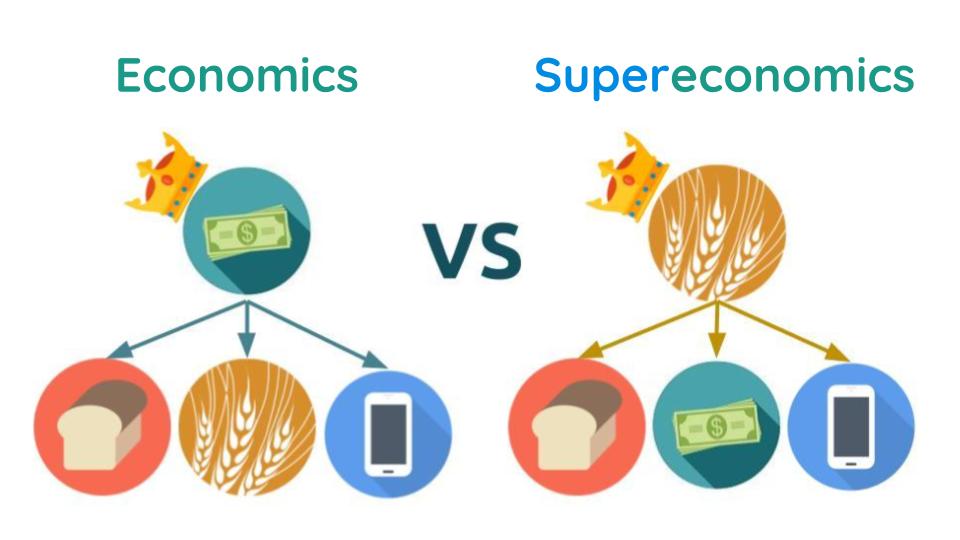Grain-based Valuation
Table of Contents
The previous chapter explained the Effort Theory of Value as the basis of Real Price.
This theory combines 2 concepts:
- Subjective effort
- Alignment of that effort with purpose
The alignment is called dharma and is fully explained in our concept of the gravitational signature.
This means that effort, as applied energy, needs to be quantified.
So how do we measure effort?
Real valuation is based on effort which is inherently subjective. It only becomes objective after buyers actually buy them.
This buying signifies an agreement or alignment between the buyer’s nominal price and the seller’s market price which includes the real price.
Our measure for effort should then be a physical thing that all buyers and sellers need and have experience with.
This can only be food since everyone needs to eat.
- Without food, no one can do any effort.
- Food also signifies life or dynamism
Economics bases value on money which is a dead, static thing. This is why economic systems need artificial stimulation.
Supereconomics bases value on life, as grains, which is a living, dyanamic thing. This is why supereconomic systems are ever-dynamic.
This is why Adam Smith explicitly mentions wheat as the measure of value.
You might not be able to print your own money or mine your own gold. But you can certainly grow your own food:
At distant times, equal amounts of labour will be bought more nearly with equal amounts of corn, the worker’s subsistence, than with perhaps any other commodity. At distant times, equal amounts of corn will enable its possessor to buy or command nearly the same amount of the labour of other people. Although equal amounts of corn will not do it exactly.
Adam Smith
An Egyptian man in 3,000 BC would need a similar amount of food that a modern man needs, even if the food yield of a hectare of wheat in both times might be very different.

The Grain Index
The first step is to build a grain index, which is a table of the relative values of goods and services to grains, as ratios.
The index acts like a guide. For example, the ratio of the quantity of rice in kilos, relative to money in units in 3 towns is given below:
| Town | Basic Rice 1 kilo | Money in Dollar units | Index |
|---|---|---|---|
| A | 1 | 1 | 1:1 |
| B | 1 | 0.95 | 1:0.95 |
| C | 1 | 0.90 | 1:0.90 |
We assign 1 point as the real value of everything in an economy. This point represents the real, subjective, metaphysical value of 1 kilogram of rice which really means the value of life.
How it Works
Assume that in Town A, Arun has a vegetable garden and Bhaskar has a small bakery.
Arun wants to buy 1 small cake worth $1. He has the following which he can offer:

| Item | Nominal Money Price | Real Value per unit or kilo |
|---|---|---|
| Dollars | $1 | 1 point |
| Tomatoes | $2 per kilo | 2 points |
| String Beans | $1.5 per kilo | 1.5 points |
| Cake | $1 | 1 point |
Since the cake is 1 point, then he can make the following offers to Bhaskar:
- $1
- 0.5 kilos of Tomatoes
- 0.6 kilos of String Beans
These all have the same real price of 1 point relative to both Arun and Bhaskar.
Of course, Bhaskar would readily choose the $1 since it is legal tender and can purchase other things that are for sale. We can regard this flexibility of money as a premium that adds to its real exchangeable value.
However, he might choose to get tomatoes since that includes free delivery which can also be seen as a premuim.
The determining factor is the effective demand of Bhaskar, which is totally subjective.
Assume that Bhaskar opts for 0.5 kilos of tomatoes as payment for 1 cake. At that point, the tomatoes become the market value while 1 point is the market price.
| Trader | Nominal Price or Value | Real Price (Value) | Natural Price (Value) | Market Price (Value) |
|---|---|---|---|---|
| Arun’s Tomato | $1 | 1 point (1 cake) | 1 point (1 cake) | $1 (1 point) |
| Bhaskar’s Cake | $1 | 1 point (0.5 kg tomato) | 1 point (0.5 kg tomato) | $1 (1 point) |
Natural and Market Prices will be explained in Parts 3 and 4.